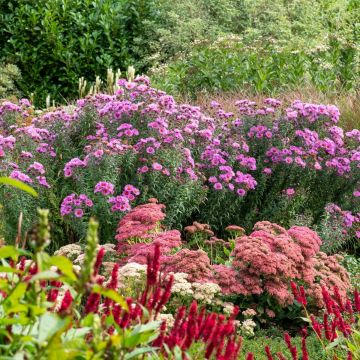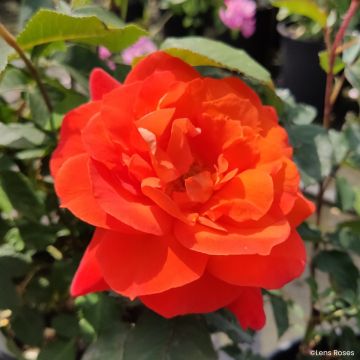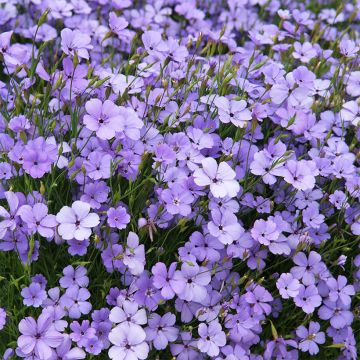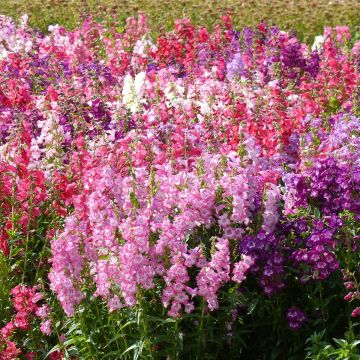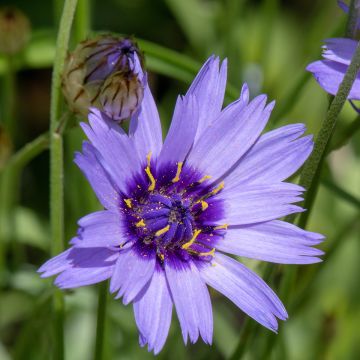

Salvia horminum Claryssa Mixed - Painted Sage Seeds
Salvia horminum Claryssa Mixed - Painted Sage Seeds
Salvia viridis var. comata Claryssa Mixed
Sage
Order delivered on the scheduled date Perfect packaging
Robert P., 25/03/2017
Special offer!
Receive a €20 voucher for any order over €90 (excluding delivery costs, credit notes, and plastic-free options)!
1- Add your favorite plants to your cart.
2- Once you have reached €90, confirm your order (you can even choose the delivery date!).
3- As soon as your order is shipped, you will receive an email containing your voucher code, valid for 3 months (90 days).
Your voucher is unique and can only be used once, for any order with a minimum value of €20, excluding delivery costs.
Can be combined with other current offers, non-divisible and non-refundable.
Why not try an alternative variety in stock?
View all →This plant carries a 6 months recovery warranty
More information
We guarantee the quality of our plants for a full growing cycle, and will replace at our expense any plant that fails to recover under normal climatic and planting conditions.

Would this plant suit my garden?
Set up your Plantfit profile →
Description
This painted sage mix, also called Salvia horminum, or Salvia viridis var. comata Claryssa Mixed, is a true annual plant, native to the Mediterranean basin. This mix presents heavy blooming plants with a compact habit, whose upright stems bear small, little flowers arranged in clusters carrying large, highly decorative bracts that come in a range of very bright colours: white, purple or pink. Its foliage, like that of other sages, is hairy. They make perfect cut or dried flowers. They are also easy to grow, undemanding and relatively drought resistant. Sow directly in Spring.
Salvia viridis is an annual sage, also called painted sage, that belongs to the family Lamiaceae. It grows naturally in dry, arid areas around the Mediterranean. It has given rise to numerous cultivars, including 'Claryssa'. The plants of the 'Claryssa Mixed' selection quickly form 40 cm high mounds with an upright, bushy habit, that are sometimes branched at their base. They have oval or oblong, 5 cm long, hairy, finely crenate, dark green leaves. Flowering lasts about a month, from July to September, depending on the date of sowing. The white, purple or mauve flowers are quite small and are arranged in clusters in the shape of spikes. They are surrounded by large sterile bracts that are brightly coloured in shades of either white, purple or pink and are marked with even darker veins. These inflorescences are very melliferous and have the particularity of remaining ornamental once dry.
Annual 'Claryssa Mixed' sage plants or one of the finest bedding plants there are, offering sumptuous spikes in the brightest of colours. Easy to grow, they are perfect for decorating beds or a terrace in no time. They can be sown directly, together with love-in-a-mist, cosmos, California poppies, for example, in order to quickly create a lovely rural setting. They are very useful in dried flower arrangements, accompanied by poppy fruits and sea lavender.
Flowering
Foliage
Plant habit
Botanical data
Salvia
viridis var. comata
Claryssa Mixed
Lamiaceae
Sage
Cultivar or hybrid
Other Thompson and Morgan seeds
View all →Planting and care
Sowing is usually done directly. This technique gives the best results.
Sow directly in their final positions in spring (April-May), in well cultivated soil that has been raked to a fine tilth, by burying the seeds under 3 mm of vermiculite. Then thin out, leaving only one seedling every 30 cm.
Sowing in a seed tray is also possible:
Sow in February and March, in a tray filled with artificial, sterilized compost, without covering the seeds as they need light to germinate. Place the tray at a temperature of 24 °C. Germination will take 10 to 14 days. Three weeks after sowing, prick out the seeds in small pots filled with sandy soil. Sage are sensitive to damping-off so it is advisable to use a fungicide 10 days after emergence.
Grow in a bright position, at the cool temperature of 16 °C. Only water when the soil is dry. Fertilize in moderation, every three weeks with a balanced fertilizer that has been diluted by half.
Transplant outdoors in the third week of May, at a distance of 30 cm for varieties such as Claryssa Mixed. Sage likes full sun or light shade and prefers rich, well drained soil. Cutting off the wilted flowers encourages the plants to flower continuously. Applying a soluble fertilizer occasionally is recommended.
Sowing period
Intended location
Planting & care advice
-
, onOrder confirmed
Reply from on Promesse de fleurs
Haven't found what you were looking for?
Hardiness is the lowest winter temperature a plant can endure without suffering serious damage or even dying. However, hardiness is affected by location (a sheltered area, such as a patio), protection (winter cover) and soil type (hardiness is improved by well-drained soil).

Photo Sharing Terms & Conditions
In order to encourage gardeners to interact and share their experiences, Promesse de fleurs offers various media enabling content to be uploaded onto its Site - in particular via the ‘Photo sharing’ module.
The User agrees to refrain from:
- Posting any content that is illegal, prejudicial, insulting, racist, inciteful to hatred, revisionist, contrary to public decency, that infringes on privacy or on the privacy rights of third parties, in particular the publicity rights of persons and goods, intellectual property rights, or the right to privacy.
- Submitting content on behalf of a third party;
- Impersonate the identity of a third party and/or publish any personal information about a third party;
In general, the User undertakes to refrain from any unethical behaviour.
All Content (in particular text, comments, files, images, photos, videos, creative works, etc.), which may be subject to property or intellectual property rights, image or other private rights, shall remain the property of the User, subject to the limited rights granted by the terms of the licence granted by Promesse de fleurs as stated below. Users are at liberty to publish or not to publish such Content on the Site, notably via the ‘Photo Sharing’ facility, and accept that this Content shall be made public and freely accessible, notably on the Internet.
Users further acknowledge, undertake to have ,and guarantee that they hold all necessary rights and permissions to publish such material on the Site, in particular with regard to the legislation in force pertaining to any privacy, property, intellectual property, image, or contractual rights, or rights of any other nature. By publishing such Content on the Site, Users acknowledge accepting full liability as publishers of the Content within the meaning of the law, and grant Promesse de fleurs, free of charge, an inclusive, worldwide licence for the said Content for the entire duration of its publication, including all reproduction, representation, up/downloading, displaying, performing, transmission, and storage rights.
Users also grant permission for their name to be linked to the Content and accept that this link may not always be made available.
By engaging in posting material, Users consent to their Content becoming automatically accessible on the Internet, in particular on other sites and/or blogs and/or web pages of the Promesse de fleurs site, including in particular social pages and the Promesse de fleurs catalogue.
Users may secure the removal of entrusted content free of charge by issuing a simple request via our contact form.
The flowering period indicated on our website applies to countries and regions located in USDA zone 8 (France, the United Kingdom, Ireland, the Netherlands, etc.)
It will vary according to where you live:
- In zones 9 to 10 (Italy, Spain, Greece, etc.), flowering will occur about 2 to 4 weeks earlier.
- In zones 6 to 7 (Germany, Poland, Slovenia, and lower mountainous regions), flowering will be delayed by 2 to 3 weeks.
- In zone 5 (Central Europe, Scandinavia), blooming will be delayed by 3 to 5 weeks.
In temperate climates, pruning of spring-flowering shrubs (forsythia, spireas, etc.) should be done just after flowering.
Pruning of summer-flowering shrubs (Indian Lilac, Perovskia, etc.) can be done in winter or spring.
In cold regions as well as with frost-sensitive plants, avoid pruning too early when severe frosts may still occur.
The planting period indicated on our website applies to countries and regions located in USDA zone 8 (France, United Kingdom, Ireland, Netherlands).
It will vary according to where you live:
- In Mediterranean zones (Marseille, Madrid, Milan, etc.), autumn and winter are the best planting periods.
- In continental zones (Strasbourg, Munich, Vienna, etc.), delay planting by 2 to 3 weeks in spring and bring it forward by 2 to 4 weeks in autumn.
- In mountainous regions (the Alps, Pyrenees, Carpathians, etc.), it is best to plant in late spring (May-June) or late summer (August-September).
The harvesting period indicated on our website applies to countries and regions in USDA zone 8 (France, England, Ireland, the Netherlands).
In colder areas (Scandinavia, Poland, Austria...) fruit and vegetable harvests are likely to be delayed by 3-4 weeks.
In warmer areas (Italy, Spain, Greece, etc.), harvesting will probably take place earlier, depending on weather conditions.
The sowing periods indicated on our website apply to countries and regions within USDA Zone 8 (France, UK, Ireland, Netherlands).
In colder areas (Scandinavia, Poland, Austria...), delay any outdoor sowing by 3-4 weeks, or sow under glass.
In warmer climes (Italy, Spain, Greece, etc.), bring outdoor sowing forward by a few weeks.






























